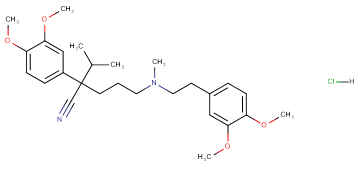
Verapamil hydrochloride
CAS No. 152-11-4
Verapamil hydrochloride( NSC 272366 | NSC 657799 )
Catalog No. M12122 CAS No. 152-11-4
Verapamil Hcl is an L-type calcium channel blocker of the phenylalkylamine class.
Purity : >98% (HPLC)
 COA
COA
 Datasheet
Datasheet
 HNMR
HNMR
 HPLC
HPLC
 MSDS
MSDS
 Handing Instructions
Handing Instructions
| Size | Price / USD | Stock | Quantity |
| 500MG | 37 | In Stock |


|
| 1G | 43 | In Stock |


|
Biological Information
-
Product NameVerapamil hydrochloride
-
NoteResearch use only, not for human use.
-
Brief DescriptionVerapamil Hcl is an L-type calcium channel blocker of the phenylalkylamine class.
-
DescriptionVerapamil Hcl is an L-type calcium channel blocker of the phenylalkylamine class.(In Vitro):The EverFluor FL Verapamil (EFV) uptake by TR-iBRB2 cells is inhibited by cationic drugs, and inhibits by verapamil in a concentration-dependent manner with an IC50 of 98.0 μM.(In Vivo):Given orally Verapamil is useful for the prophylaxis of atrioventricular reentry tachycardia, and also in modulating the atrioventricular nodal response in atrial fibrillation.Verapamil is injected i.v. into a femoral vein prior to ischemia. Verapamil (1 mg/kg) significantly decreases the incidence of ventricular arrhythmias including premature ventricular contractions (PVC), ventricular tachycardia (VT) and ventricular fibrillation (VF) for 45-min coronary artery occlusion. Total arrhythmia scores are significantly increased when the heart is subjected to ischemia. Verapamil (1 mg/kg) significantly prevents the enhancement of total arrhythmia scores induced by ischemia.
-
In VitroThe EverFluor FL Verapamil (EFV) uptake by TR-iBRB2 cells is inhibited by cationic drugs, and inhibits by verapamil in a concentration-dependent manner with an IC50 of 98.0 μM.
-
In VivoGiven orally Verapamil is useful for the prophylaxis of atrioventricular reentry tachycardia, and also in modulating the atrioventricular nodal response in atrial fibrillation.Verapamil is injected i.v. into a femoral vein prior to ischemia. Verapamil (1 mg/kg) significantly decreases the incidence of ventricular arrhythmias including premature ventricular contractions (PVC), ventricular tachycardia (VT) and ventricular fibrillation (VF) for 45-min coronary artery occlusion. Total arrhythmia scores are significantly increased when the heart is subjected to ischemia. Verapamil (1 mg/kg) significantly prevents the enhancement of total arrhythmia scores induced by ischemia.
-
SynonymsNSC 272366 | NSC 657799
-
PathwayGPCR/G Protein
-
TargetCalcium Channel
-
RecptorCalcium Channel
-
Research AreaCardiovascular Disease
-
Indication——
Chemical Information
-
CAS Number152-11-4
-
Formula Weight491.06
-
Molecular FormulaC27H39ClN2O4
-
Purity>98% (HPLC)
-
SolubilityEthanol: 12 mg/mL (24.43 mM); Water: 50 mg/mL (101.82 mM); DMSO: 98 mg/mL (199.56 mM)
-
SMILESN#CC(C(C)C)(C1=CC=C(OC)C(OC)=C1)CCCN(CCC2=CC=C(OC)C(OC)=C2)C.[H]Cl
-
Chemical Name2-(3,4-dimethoxyphenyl)-5-[2-(3,4-dimethoxyphenyl)ethyl-methylamino]-2-propan-2-ylpentanenitrile hydrochloride
Shipping & Storage Information
-
Storage(-20℃)
-
ShippingWith Ice Pack
-
Stability≥ 2 years
Reference
1.Dilmac N, et al. Mol Pharmacol. 2004 Nov;66(5):1236-47.
molnova catalog



related products
-
Pranidipine
Pranidipine is a novel, long-acting 1,4-dihydropyridine calcium channel blocker.
-
1-(aminomethyl)cyclo...
1-(aminomethyl)cyclopropanecarboxylic acid hydrochloride inhibits L amino acid transporter proteins and the α2δ subunit of voltage-gated calcium channels.
-
Sesamodil
Sesamodil (SD 3211) is a novel calcium antagonist that can be used to study hypertension.



 Cart
Cart
 sales@molnova.com
sales@molnova.com


